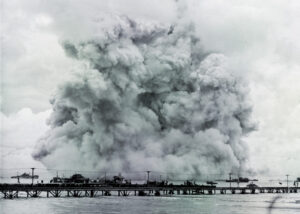By 1802, professional naval opinion in Britain had concluded that the 44-gun frigate, armed with 24-pound cannons on the gun deck, was a failure. Drawing from their war experience with Revolutionary France, during which 6 new French 44-gun frigates were sunk or captured, the British Admiralty remained confident that in the main, their more nimble 18 pound frigates, requiring smaller crews, would be more than a match for the new super-frigates. To hedge their bets however, England ‘razeed’ (cut down) three 64-gun ships into 44’s, and launched several purpose-built 44’s.
Even contemporary American opinion on the 44’s was sharply divided when on March 24, 1794, Congress authorized the construction of four 44-gun frigates as part of its first naval bill. Later reduced to three 44-gun frigates, the Constitution, United States, and President were the leviathans of their class, pocket battleships in 20th century terminology. At a length of 175 feet and displacing 1,575 tons, they were longer and heavier than British 38’s and even 16 feet longer and 23% heavier than the 40 gun, 24-pounder British Endymion class commissioned starting in 1797. A self-taught naval architect from Philadelphia, Joshua Humphreys staked his reputation on his super-frigates. Humphreys had 20 years since the Revolutionary War to reflect on the merits of the successful smaller 32 gun frigates like the Confederacy and it is apparent that he improved on their design in one significant way. He reasoned that a new class of 44-gun frigates could outfight any frigate and meet a 74-gun ship of the line on reasonably equal terms. Built with hard live oak transported from the Carolinas, with 2 foot thick transverse framing timbers spaced only 2 inches apart, Humphrey’s 44’s had scantlings worthy of a 74 gun ship of the line, and nearly their weight of broadside. While their initial armament placed smaller long guns on the spar or upper deck, extensive refits carried out prior to the outbreak of the War of 1812 replaced these smaller guns with 42 pound carronades, short-range, snub-nose cannons nicknamed “smashers” (the Constitution mounted 32 pound carronades). For comparison, the United States carried a weight of broadside of 888 pounds while a British 74 (armed with upper deck carronades) could discharge 1,000 pounds. Bolstering Humphrey’s design theory, a British 74, with its lower 32 pound gun deck ports closed in rough weather, would be reduced to a broadside weight of 552 pounds, with the American 44 holding a long range advantage with its main battery of 24 pounders. The very nature of this powerful, short-range armament revealed that Americans intended to emulate their British cousins in close action fighting. The introduction of thin, sheet-lead powder cartridges enabled Yankee gunners to discharge 3 shots for every 2 by the British, while the addition of gun sights improved long-range accuracy.
Despite their impressive record, the American 44’s were not without defects or criticism. Their unsurpassed length came at the cost of hogging, the tendency of the ship’s keel to sag downward at both ends due to the heavy weight carried fore and aft. By 1811, the British perfected the method of diagonal inner bracing to prevent hogging. The deep draft of these super frigates limited the ports that they could use. Their initial sail plan made them laggardly sailers, under-sparred with only courses, topsails and topgallants for motive power. Later modifications by their captains to include royals and skysails transformed the Constitution and especially the President into ocean greyhounds, while the United States, weighted down by the addition of a roundhouse in its stern, remained a dull sailer.
British ridicule of the American 44’s quickly dissipated after 3 stunning frigate defeats in the opening months of the War of 1812 at the hands of the Constitution (twice) and the United States. Thereafter, the British admiral commanding the North American station issued unprecedented orders that the American 44’s were not to be engaged by British frigates single-handedly. The Admiralty followed this in 1813 by commencing a crash program to build 24-pounder spar-decked frigates known as the Leander and Newcastle class. Their single-minded determination to capture an American 44 was rewarded when a British squadron overwhelmed the President in a raging winter storm off Long Island in January, 1815. Too badly damaged to repair, the British were so impressed with her design that they built an exact replica of the same name. On purely technical merits, the big American 38’s like Philadelphia and Constellation were better ships, but future American frigates were built to the same basic design as the original spar-decked 44’s.
In a larger sense, the impressive string of naval victories by the 44’s and other smaller ships boosted American morale at a critical period of the war, and prompted Congress in 1816 to authorize the construction of 6 ships of the line and 9 heavy frigates.




